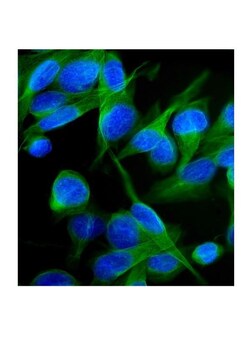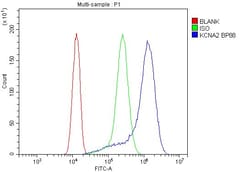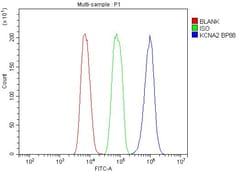Learn More
Invitrogen™ KV1.2 (KCNA2) Polyclonal Antibody
Rabbit Polyclonal Antibody
Supplier: Invitrogen™ PA5144086
Description
Adding 0.2 mL of distilled water will yield a concentration of 500 μg/mL. Immunogen sequence is identical to the related mouse and rat sequences. Positive Control - WB: Rat Kidney Tissue, Rat Brain Tissue, Mouse Brain Tissue, Mouse Kidney Tissue. ICC/IF: U20S cell. Flow: A431 cell, C6 cell. Store at -20°C for one year from date of receipt. After reconstitution, at 4°C for one month. It can also be aliquotted and stored frozen at -20°C for six months. Avoid repeated freeze-thaw cycles.
Kcna2 is a voltage-gated potassium channel (KV) that belongs to the 6-TM family of potassium channel and also comprises the Ca2+-activated Slo (actually 7-TM) and the Ca2+-activated SK subfamilies. The alpha-subunits contain a single pore-forming region and combine to form tetramers. Potassium channels represent the most complex class of voltage-gated ion channels from both functional and structural standpoints. The diverse functions of potassium channels include regulating neurotransmitter release, heart rate, insulin secretion, neuronal excitability, epithelial electrolyte transport, smooth muscle contraction, and cell volume. Four sequence-related potassium channel genes - shaker, shaw, shab, and shal - have been identified in Drosophila, and each has been shown to have human homolog(s). The Kcna2 gene encodes a member of the potassium channel, voltage-gated, shaker-related subfamily. Kcna2 contains six membrane-spanning domains with a shaker-type repeat in the fourth segment. Further, Kcna2 belongs to the delayed rectifier class, members of which allow nerve cells to efficiently repolarize following an action potential. The coding region of the Kcna2 gene is intronless, and the gene is clustered with genes KCNA3 and KCNA10 on chromosome 1. Diseases associated with KCNA2 include Epileptic Encephalopathy (Early Infantile, 32) and Undetermined Early-Onset Epileptic Encephalopathy.
Specifications
| KV1.2 (KCNA2) | |
| Polyclonal | |
| Unconjugated | |
| KCNA2 | |
| Akr6a4; BK2; CSMK1; delayed rectifier K+ channel; EIEE32; ENSMUSG00000074335; Gm10672; HBK5; HK4; HUKIV; k(v)1.2; KC22; Kca1-2; kcna2; kcna2.S; kcna2-a; KV1.2; Kv1.2' potassium channel; LOC100537815; MK2; Mk-2; NGK1; Potassium (K+) channel protein alpha 2, voltage dependent; potassium channel (BGK5); potassium channel subunit Kv 1.2; potassium channel, voltage gated shaker related subfamily A, member 2; potassium channel, voltage gated shaker related subfamily A, member 2 S homeolog; potassium voltage gated channel shaker related subfamily member 2; potassium voltage-gated channel subfamily A member 2; potassium voltage-gated channel, shaker-related subfamily, member 2; potassium voltage-gated channel, shaker-related subfamily, member 2 a; RAK; RBK2; RCK5; RP11-284N8.1; voltage-dependent K channel; voltage-gated channel, shaker-related subfamily, member 2; voltage-gated K(+) channel HuKIV; Voltage-gated potassium channel HBK5; voltage-gated potassium channel isoform 2; voltage-gated potassium channel isoform 3; voltage-gated potassium channel protein Kv1.2; Voltage-gated potassium channel subunit Kv1.2; XELAEV_18011981mg; XSha2 | |
| Rabbit | |
| Antigen affinity chromatography | |
| RUO | |
| 16490, 25468, 3737 | |
| -20°C | |
| Lyophilized |
| Flow Cytometry, Western Blot, Immunocytochemistry | |
| 500 μg/mL | |
| PBS with 5mg BSA and 0.05mg sodium azide | |
| P16389, P63141, P63142 | |
| KCNA2 | |
| A synthetic peptide corresponding to a sequence at the C-terminus of human Kv1.2 (466-499aa NNSNEDFREENLKTANCTLANTNYVNITKMLTDV). | |
| 100 μg | |
| Primary | |
| Human, Mouse, Rat | |
| Antibody | |
| IgG |
Your input is important to us. Please complete this form to provide feedback related to the content on this product.



